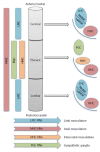Quo vadis motor neuron disease?
- PMID: 27019797
- PMCID: PMC4804252
- DOI: 10.5662/wjm.v6.i1.56
Quo vadis motor neuron disease?
Abstract
Motor neuron disease (MND), also known as amyotrophic lateral sclerosis, is a relentlessly progressive neurodegenerative condition that is invariably fatal, usually within 3 to 5 years of diagnosis. The aetio-pathogenesis of MND remains unresolved and no effective treatments exist. The only Food and Drug Administration approved disease modifying therapy is riluzole, a glutamate antagonist, which prolongs survival by up to 3 mo. Current management is largely symptomatic/supportive. There is therefore a desperate and unmet clinical need for discovery of disease mechanisms to guide novel therapeutic strategy. In this review, we start by introducing the organizational anatomy of the motor system, before providing a clinical overview of its dysfunction specifically in MND. We then summarize insights gained from pathological, genetic and animal models and conclude by speculating on optimal strategies to drive the step change in discovery, which is so desperately needed in this arena.
Keywords: Amyotrophic lateral sclerosis; Disease models; Motor neuron disease; Neurodegeneration.
Figures

References
-
- Kuffler SW, Hunt CC, Quilliam JP. Function of medullated small-nerve fibers in mammalian ventral roots; efferent muscle spindle innervation. J Neurophysiol. 1951;14:29–54. - PubMed
-
- Burke RE, Strick PL, Kanda K, Kim CC, Walmsley B. Anatomy of medial gastrocnemius and soleus motor nuclei in cat spinal cord. J Neurophysiol. 1977;40:667–680. - PubMed
Publication types
LinkOut - more resources
Full Text Sources
Other Literature Sources

